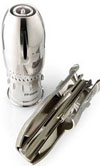Pin Critical
 The article on Advanced Metals last month looked at some of the titanium alloys currently being used in racing engines, and some of the alloys currently under development. The article mentioned that, despite restrictions on the introduction of new materials in Formula One, the engine manufacturers continue to invest time and resources to investigate materials development. The two main uses for titanium in racing engines currently are con rods and valves, although there have been efforts to replace most components that have traditionally been made in steel.
The article on Advanced Metals last month looked at some of the titanium alloys currently being used in racing engines, and some of the alloys currently under development. The article mentioned that, despite restrictions on the introduction of new materials in Formula One, the engine manufacturers continue to invest time and resources to investigate materials development. The two main uses for titanium in racing engines currently are con rods and valves, although there have been efforts to replace most components that have traditionally been made in steel.
It is rumoured that at least one manufacturer has seriously investigated titanium as a crankshaft material in Formula One, although this was some years ago, and I’m not aware of anybody looking at this currently. The steel crankshafts currently used in Formula One are highly optimised and to change to a material with such different mechanical characteristics would require big changes. Certainly we could expect crankpin diameters to be increased, and therefore the big end of the con rod would be consequently larger. This would have an impact on the crankshaft axis height from the base of the engine, requiring a deeper lower crankcase (sump), and therefore having an effect on the packaging of the engine in the car. Given the pressure that has been placed on the engine suppliers to make engines with the lowest possible crankshaft centreline height, it is doubtful that anyone would be tempted to spend any significant effort on this development.
Formula One regulations currently proscribe piston pins in materials other than an ‘iron based alloy’:
5.14.2 Piston pins must be manufactured from an iron based alloy and must be machined from a single piece of material.
However, there have been several past attempts to use titanium alloys in this application in Formula One, with varying degrees of success. I have spoken with an engineer who worked on one of the V10 engines which had hollow titanium piston pins with longitudinal fibre reinforcement. The cost of these parts was described as ‘extremely expensive’, with the material cost being a very significant reason for this expense. The material in question was produced specifically for this application.
A more pragmatic approach, and one that it certainly less expensive, is to take a commercially available titanium alloy, and machine piston pins from this, taking advantage of the lower density to produce a part of equivalent stiffness but with lower mass. The stiffness we are talking of here is the ‘crushing’ or ‘ovalisation’ stiffness, and we might size the pin to have a maximum design deflection under a given load. In a very trivial example, in maintaining the same outside diameter, the theoretical mass saving by substituting steel for titanium is in the region of 35%.
This approach of machining parts from commercially available bar stock has been followed by Formula One engine manufacturers with more limited development budgets in the past, and even some people outside of Formula One.
However, it is not simply a case of matching stiffness. Strength, and particularly in respect of fatigue, has to be carefully assessed. In this regard steels can be surface hardened to introduce significant compressive residual stress which helps to increase fatigue life. Titanium is not able to take advantage of the same levels of residual compressive stress, and therefore pins need to be of larger section than those that result from calculations to match stiffness.
If we aim to use titanium in this contact application, we need to pay special attention to surface coatings also, as titanium has notoriously poor contact behaviour.
Written by Wayne Ward.